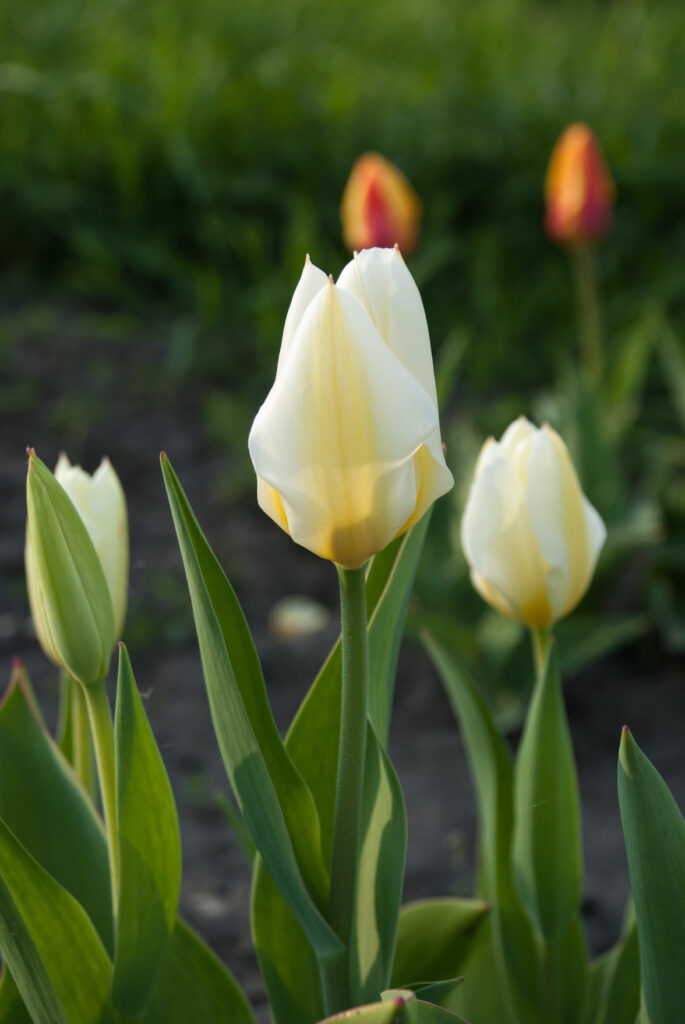Garden Solutions: Perennial Tulips

Perennial Tulips
Most tulips frustrate me. Planting them is a lot of work and the task produces absolutely no instant gratification. You dig a hole, place the bulbs and bury them, with no results for several months. If you manage to protect them from the squirrels for the rest of the fall and from the rabbits and deer in the early spring, you finally get some fleeting blooms. After all of that work, modern tulip varieties bloom sporadically (at best) in subsequent years. I’m a sucker for thankless tasks, but planting tulips is too much even for me.
I’ve always felt that tulips were betraying me when they didn’t bloom in the second year, but most of them really aren’t supposed to. Tulip breeding programs prioritize flower size and color over plant longevity, so it’s best for your mental health if you treat most tulips as annuals.
A few years ago, I discovered Tulipa praestans ‘Shogun’, a gorgeous light-orange tulip that actually gets better with time. This lovely plant blooms profusely every year and the rabbits don’t mow it down to the ground. I decided it was time to investigate my options for planting tulips that were truly perennial.
Fosteriana tulips
Members of the species Tulipa fosteriana are also known as “Emperor tulips.” These tulips have the largest flowers of the truly perennial tulips, and they most closely resemble the cup-shaped blooms most people imagine when they think of tulips. The plants are 6 to 20 inches tall, and they spread about 6 inches wide. The flower colors range from soft pinks and oranges to bright reds and yellows. The cultivar ‘Purissima’ has a white flower. They usually bloom in mid-April, and the plants reliably bloom for several years. Some cultivars have mottled or striped foliage. Since this characteristic is caused by a (non-lethal) viral infection in the plant, the foliage patterns vary widely.
Kaufmanniana tulips
Tulipa kaufmanniana cultivars are commonly called “water lily tulips” because of their flower shapes. These tulips are usually around a foot tall, and they flower in early April. In well-drained soil with high organic matter and consistent moisture, Kaufmanniana tulips will naturalize easily, especially if you don’t disturb them. ‘The First’ is a red and white striped cultivar named for its early spring appearance, while ‘Stresa’ boasts bright petals divided into bold chunks of red and yellow. Kaufmanniana tulips can also have mottled or striped foliage.
Greigii tulips
While Kaufmanniana and Fosteriana tulips sometimes sport mottled or striped leaves, Tulipa greigii is best known for this feature. These short yet showy tulips always have foliage streaked with dark purple or maroon, and the leaves are also often ruffled. Greigii tulip flowers are long and narrow with jaunty pointed petals. They flower in mid-April, and they often open and close in response to the amount of sunshine available. The plants are 6 to 12 inches tall, which makes them perfect in rock gardens or at the front of garden borders. Flower colors include pinks, reds, oranges and striped combinations of these. ‘Red Riding Hood’ is a popular red cultivar, while ‘Mary Ann’ flowers are a lovely blend of white and pink. Some cultivars are fragrant, too!
Species tulips
The term “species tulips” actually encompasses many different tulip species. Some, like my beloved Tulipa praestans ‘Shogun’, are reminiscent of the well-known annual tulips. Others, like Tulipa acuminata (aka The Fire Flame), are eccentric and flashy, with unfamiliar floral shapes. All of these tulips come back year after year, and some will naturalize under the right growing conditions. Species tulips are usually tiny compared to modern tulips, but their delicate blooms won’t fail to draw you in for a closer look. Last year, I planted 100 Tulipa humilis ‘Helene’ in my gardens, and I was thrilled with their clear pink petals and tidy growth habit. Specialty bulb companies like Van Engelen have a wide selection of species tulips available for mail order, and local garden centers are starting to carry them, too.
Perennial tulips are well worth the work and will reward you with many years of reliable, cheerful blooms.
This article by Laura Schwarz first appeared in the September/October 2020 issue of Northern Gardener® magazine.
